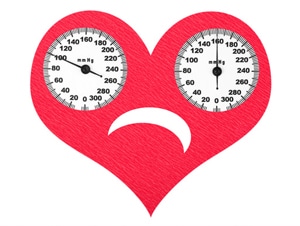
February 1, 2016
A Look At Hypertension
By Michael D. Shaw
Ah, yes. High blood pressure. No physiological parameter is easier to measure than BP, yet few health topics present more confusing advice, or are as poorly understood.
Let’s start with the basics:
“Blood pressure” is the force derived from the pumping action of your heart, as the blood pushes against the walls of blood vessels. The stretching and contraction of the vessels maintain the flow of blood throughout your body. The systolic pressure (higher number) reflects such force during a heart contraction; the diastolic (lower number) is the residual pressure between heartbeats.
Measurements of BP are done using a sphygmomanometer, the most typical embodiment of which is a cuff apparatus, designed to fit over the brachial artery. As the cuff inflates, blood flow stops temporarily. Then, the operator slowly releases the pressure, until blood flow resumes (as detected by sound–either with a stethoscope or by detection of vibration as in the popular automatic digital units). This is the systolic pressure. Further release of cuff pressure eventually yields no detectable sound. This is the diastolic pressure.
BP is reported in units of millimeters of mercury pressure, and appear as “120/80,” with systolic always shown first. Classically, “normal” BP was 120/80, with the numbers being adjusted in accordance with the fashion of the day. Likewise, hypertension has been defined as 140/90 and above. Prolonged hypertension can have serious effects…
- Aneurysms
- Chronic kidney disease
- Cognitive changes
- Eye damage
- Heart attack or heart failure
- Peripheral artery disease
- Stroke
Scary stuff, to be sure. So, let’s go into more depth on just what constitutes hypertension. Our friends at the National Heart, Lung, and Blood Institute provide the following definitions:
Normal is <120/<80 (“Baseline.” Higher when “active.”) How relaxed should you be for your baseline measurement? Good question.
Pre-Hypertension [120–139] / [80–89]
High BP Stage 1 [140–159] / [90–99]
High BP Stage 2 >160 / >100
Depending on whom you wish to believe, a separate class exists for those over age 60, whereby High BP is >150 / >90. Inasmuch as “essential” hypertension, the most common type (95% of cases), has no identifiable etiology, it is reasonable to assume that the vessels stiffen up a bit with age, eliciting the higher BP. As such, while this may not be “normal” for a 25-year-old, it might be quite normal for someone over 60.
Not surprisingly, this separate class was attacked by the usual suspects (aka the Heart Mafia), who cited a 2014 study indicating that patients with readings between 140/90 and 150/90 had slightly higher rates of cardiovascular complications compared with those who had achieved a blood pressure of 140 or lower. Of course, there was also the gigantic confounding factor that all 8,354 patients in the study had established coronary artery disease.
OK, so hypertension affects perhaps one-third of all Americans, only we have no idea what causes it. It is more common in Blacks than Caucasians and Hispanics, but PC will prevent anyone from discovering why. Beyond the loss of blood vessel elasticity with age, many other presumptive causes have been proffered…
- Stress (very likely).
- Excessive salt consumption (overblown, but always a favorite meme).
- A diet low in calcium, magnesium, and potassium (plausible).
- Obesity and the attendant insulin resistance (very likely).
- Excessive alcohol intake (difficult to prove).
- Certain meds (very likely, but choose your poison).
Pharmaceutical therapy includes ACE inhibitors, Alpha blockers, Alpha-beta blockers, Angiotensin II receptor blockers (ARB), Beta blockers, Calcium channel blockers, Diuretics, Nervous system inhibitors, and Vasodilators. All of these drugs have side effects, some of which are no joke. There’s elevated lung cancer risk (ARB); and elevated breast cancer and heart attack risk (Ca channel blockers). Milder side effects include constipation, dehydration, drowsiness, dry mouth, headaches, increased sensitivity to cold or sunlight, and upset stomach.
As always, the patient must determine if the BP reduction is worth the side effects, and for borderline cases, that is no simple matter.
